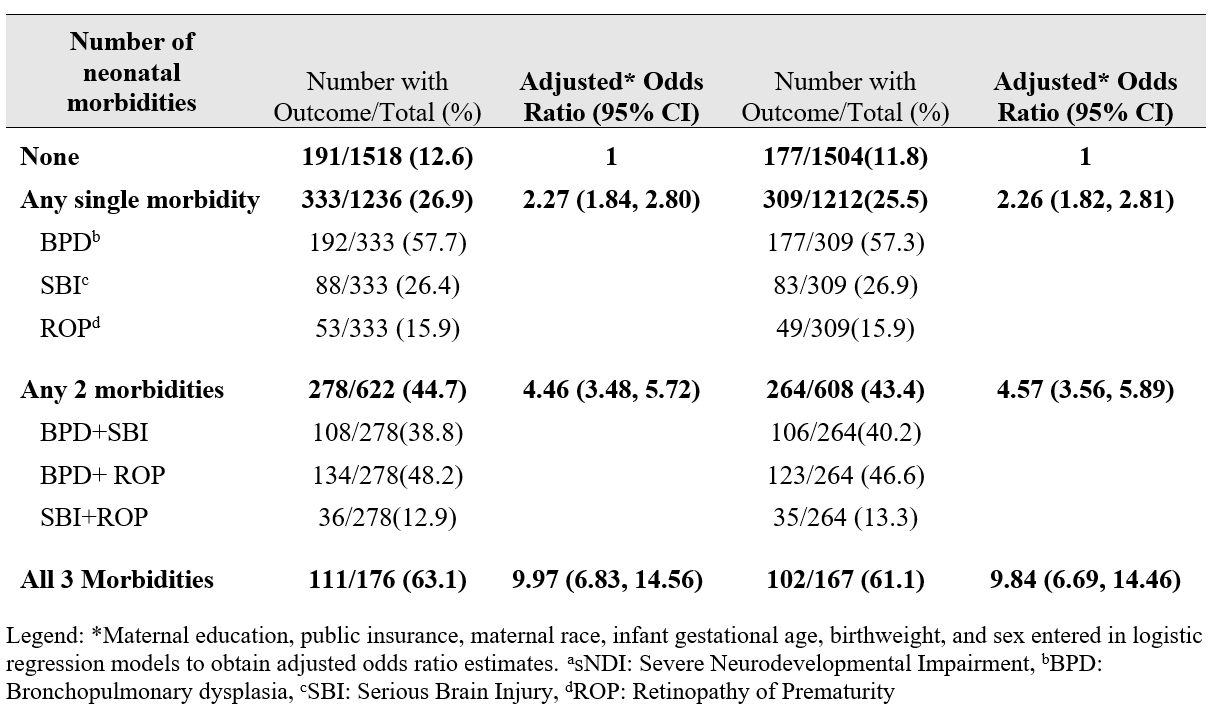Neonatology
Session: Neonatal Follow-up 4
544 - A Neonatal Morbidity Count of Brain Injury, Bronchopulmonary Dysplasia, and Retinopathy of Prematurity is Strongly Associated with Severe Neurodevelopmental Impairment in Extremely Preterm Infants
Monday, May 6, 2024
9:30 AM - 11:30 AM ET
Poster Number: 544
Publication Number: 544.3315
Publication Number: 544.3315

Rebecca A. Dorner, MD, MHS (she/her/hers)
Director of High-Risk Infant Follow-Up Clinic; Director of Neurodevelopment at the Neonatal Research Institute
Sharp Mary Birch Hospital for Women and Newborns
Presenting Author(s)
Background: Prior data suggest increased rates of death or severe neurodevelopmental impairment (sNDI; Bayley III Cognitive/Motor < 70, Gross Motor Function Classification System level IV/V, bilateral hearing impairment +/- amplification, bilateral blindness) with increasing numbers of neonatal morbidities. It is unknown if this is true in a larger contemporary cohort accounting for potential confounding factors.
Objective: To determine whether (1) neonatal morbidities present at 36 weeks postmenstrual age (PMA) in extremely preterm infants (alone or in combination) are significantly associated with death or sNDI and if (2) the magnitude of association increases with higher numbers of neonatal morbidities.
Design/Methods: Retrospective cohort study at 15 U.S. academic centers. Inborn liveborn infants 22-26 weeks gestation from 2014-2019 who survived to 36 weeks PMA with follow-up data at 22-26 months corrected age were included. First, bivariate associations between each of 7 neonatal morbidities and two-year outcome were examined. Second, logistic regression with a random center effect was used to assess the association of a count of individual morbidities with the strongest bivariate associations with two-year outcome.
Results: Among 4476 eligible infants, 3602 infants had a known outcome at follow-up. Serious brain injury (SBI; Grade 3 or 4 intraventricular hemorrhage (IVH), intraparenchymal echodense lesions, cystic periventricular leukomalacia, porencephalic cysts, ventriculomegaly with or without IVH, cerebellar hemorrhage), severe retinopathy of prematurity (ROP; unilateral or bilateral disease of stage 4 or 5 or receipt of retinal therapy), and bronchopulmonary dysplasia (BPD; Grade 2 or 3 per Jensen’s criteria) had the largest odds ratios for death or sNDI and isolated sNDI (Table 1). Moreover, the presence of increasing numbers of these 3 morbidities was associated with increased odds of death or sNDI and sNDI (Table 2, Figure 1). These results held after adjusting for maternal and infant characteristics including maternal education, public insurance, maternal race, gestational age, birthweight, and sex.
Conclusion(s): In extremely preterm infants who survived to 36 weeks PMA, SBI, BPD and severe ROP were strongly associated with sNDI. The odds of sNDI increased proportionally with a morbidity count. Our findings are consistent with observational data from two decades ago and support the use of morbidities to predict two-year outcome.
.png)

.png)
